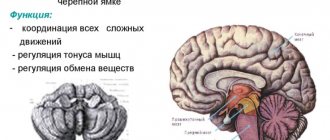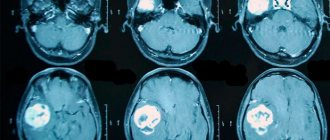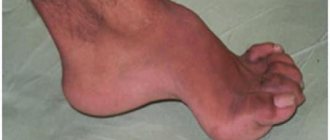What is cerebellar cancer
Cerebellar cancers include tumors that contain mutated cells. The disease is malignant in nature and causes serious complications.
On this topic
- Neuro-oncology
How does a headache hurt with brain cancer?
- Olga Vladimirovna Khazova
- December 3, 2021
According to statistics, pathology is detected in 30% of cases of brain formations. Using histological examination, more than 100 types of neoplasms are determined.
Cancer of the cerebellum can occur regardless of age. Certain types are typical for middle-aged and older patients, and some types of tumors are detected only in children.
About the symptoms of cerebellar tumors by stage
Tumors of the cerebellum are expressed in various symptoms and can be classified as cerebral, cerebellar, or stem.
Among the general cerebral manifestations, the following manifestations should be mentioned:
- Head pain, attacks of nausea, vomiting
Symptoms of cerebellar tumors - in the initial and advanced stages - most often include headaches and attacks of nausea. As the formation grows, it blocks fluid around the brain, and this leads to hydrocephalus or increased fluid content inside the skull. Such an excess causes an increase in internal pressure, which means the appearance of nausea, headaches, sometimes quite significant (after waking up), leading to vomiting. Standard painkillers do not help much; later the pain usually decreases.
- Changes in gait
The cerebellum controls muscle coordination. As the formations of this organ grow, excessive pressure in the inner part of the skull can harm its functions. Sometimes clumsiness may develop and coordination of movements may be impaired. Such a tumor ultimately provokes changes in gait - it turns into a swaying, unstable one.
- Cranial nerve injuries
The posterior cranial fossa is characterized by its small size. In a number of situations, the growth of the formation fills its space; it can cause harm to adjacent structures, for example, cranial nerves. When nerves are injured, pupils become enlarged, peripheral vision is lost, the eyeball deviates, and vision is blurred. Sometimes weakness of the facial muscles may develop, disruptions in the sensitivity of the facial zones may occur, hearing loss may occur, and the perception of taste may be impaired.
Diagnosis is based on the results of MRI of cerebral structures. As for the final verification of the diagnosis, it occurs only on the basis of a histological examination of the structures of the tumor itself. Treatment occurs surgically and usually consists of eliminating the insidious neoplasm.
Classification
Cerebellar cancer includes several types depending on the location and characteristics of the course.
Intracerebral
Neoplasms are localized within the brain, as they develop, they affect neighboring organ tissues and provoke the development of severe symptoms. The most common are astrocytoma, hemangioblastoma, and ependymoma. Medulloblastoma is also identified as the most common cancer.
Medulloblastoma
This type of tumor is most often detected. It is installed in both children and adults. Characterized by rapid growth. It may take several weeks from the time cell transformation begins until the first symptoms appear.
Meduloblastoma is considered the most aggressive type of tumor, as it is accompanied by intracranial hypertension, which occurs against the background of impaired outflow of cerebrospinal fluid.
It is localized mainly in the cerebellar vermis, and the lesion extends to the hemisphere. When the formation grows rapidly, the pathological process is accompanied by infiltration of the posterior surface of the brain stem.
Experts distinguish two types of tumors. The first one is “classic”. The second is called desmoplastic. Previously it was called sarcoma.
Extracerebral
Neoplasms belonging to this category are formed outside the brain tissue, but as they increase in size they grow into the cerebellum.
Formations of this type include chordoma, meningioma, teratoma, and neuroma.
Scientists also classify brain stem tumors and metastatic lesions affecting the cerebellum into separate categories.
Such formations pose a danger to the body, since the probability of metastases spreading exceeds 60%. Mutated cells penetrate the lungs, liver, and kidneys.
Pain plus vomiting
What symptoms should alert moms and dads first?
Neurologist , Candidate of Medical Sciences, senior researcher at the children's department of the National Medical Research Center of Neurosurgery named after. ak. N. N. Burdenko Elena Khukhlaeva :
– The first signs of a brain tumor are very varied. One of the most common symptoms is headache. If a child is bothered by headaches, then you should definitely consult a neurologist, and not attribute the malaise to overexertion and stress at school. In addition to a neurologist, if you have a headache, you should definitely contact an ophthalmologist, who will examine the fundus of the eye. And if a headache occurs at night or in the morning and is also accompanied by vomiting, then a visit to a neurologist should under no circumstances be postponed.
Article on the topic
The main thing is support. Help from psychologists in the fight against cancer Early signs of a brain tumor can also be focal symptoms caused by damage to a specific area of the brain. There are many such symptoms: epileptic seizures, unilateral limitation of movements in the limbs, strabismus, weakness of the facial muscles, swallowing disorders, impaired voice quality, morning vomiting.
In children of the first year of life, it is important to measure the head circumference and in case of accelerated growth, it is necessary to immediately contact a neurologist and pediatrician. There is only one method that allows you to confirm or refute the diagnosis of a brain tumor - an MRI of the brain. The main task of parents is to promptly contact specialists with their child, and then trust the professionals, try to remain calm and, of course, remember that the chance of recovery for neurosurgical pathology in children is currently very high.
Causes
Experts today cannot answer the question of what provokes the development of cancerous tumors in the tissues of the cerebellum and other parts of the brain. But with the help of many studies, a number of predisposing factors have been established. According to scientists, it is their influence that increases the likelihood of the disease occurring.
Neoplasms of various types that affect the cerebellum can form against the background of prolonged radioactive or ionizing exposure. A large dose of radiation can also be a provocateur.
Experts believe that one of the reasons for the formation of tumors is the presence of oncogenic viruses. These include adenoviruses, herpes, HIV and HPV.
On this topic
- Neuro-oncology
Who needs to be tested for tumor markers for brain cancer?
- Olga Vladimirovna Khazova
- May 27, 2021
Geneticists say that some types of brain cancers begin to form as a result of a genetic predisposition. At the same time, the patient’s close relatives also suffer from similar pathologies.
Factors that affect the body and increase the risk of developing tumors not only in the tissues of the cerebellum, but also in other parts of the brain include:
- Bad habits. This includes smoking and drinking alcohol.
- Chemical, toxic and poisonous substances, as well as heavy metals penetrating through the skin and respiratory tract.
- Unfavorable environmental conditions. The risk group includes people living near plants and factories.
The development of tumors in the cerebellum is often provoked by the influence of several factors.
Symptoms and signs
Malignant tumors that form on the tissues of the cerebellum are accompanied by a variety of symptoms, which are divided into three categories: cerebral, distant and local. They all flow in parallel, intersect and merge with each other.
General cerebral
They appear in the early stages of tumor development. One of the most pronounced disorders is called congestive nipple. This condition is accompanied by changes in blood supply and circulation of brain fluid. As a result, retinal congestion occurs.
A nonspecific general cerebral symptom is headache. It can manifest itself both in the early stages and not in later stages. In addition, the symptom is characteristic of cancerous and benign neoplasms.
Painful sensations are localized in the occipital part, over time it covers the entire head. Headaches are often associated with the occurrence of a “stagnant labyrinth,” which has serious consequences and makes it difficult to make an accurate diagnosis.
On this topic
- Neuro-oncology
What are the consequences of brain radiosurgery?
- Olga Vladimirovna Khazova
- May 27, 2021
Patients complain of dizziness, decreased quality of vision, and breathing problems. Symptoms appear against the background of compression of neighboring structures, when the neoplasm increases in size.
When pressure is applied to the respiratory center of the brain, asphyxia can occur while the person is sleeping.
Distant signs
They appear at later stages and have a pronounced character. The most common signs are paralysis and seizures.
When the tumor affects the cerebellum, patients experience unilateral symptoms. The disease has a slow course. But as a result of the influence of certain negative factors, an exacerbation occurs, which leads to the spread of the pathological process to neighboring structures.
When the tumor reaches a large size, blockage of the outflow tract of liquor fluid is noted. In this case, all symptoms intensify.
Patients experience symptoms such as loss of coordination, hand tremors, and increased intracranial pressure. There is a decrease in hearing and vision up to their complete loss.
In addition, at stages 2 and 3 severe headaches, vomiting, weakness of muscle tissue, and wobbling of the eyeballs appear.
Nesting
Symptoms in this category are similar to general cerebral and distant signs, but are more pronounced.
They are also accompanied by dysfunction of many organs affected by metastases.
Symptoms of the disease
All cerebellar tumors, symptoms and signs of development, are conventionally divided into three groups:
- General cerebral (occur due to impaired circulation of cerebrospinal fluid).
- Distant (develop against the background of compression of neighboring structures).
- Focal, that is, affecting the functioning of the cerebellum.
They usually appear simultaneously, but their strength may vary depending on the intensity of growth of the neoplasm, its location and impact on neighboring structures.
Due to the location of the “motor center” (it is located above the 4th ventricle behind the brain stem), in each case there is an increase in the symptoms of a cerebellar tumor. But it can vary depending on the intensity of tumor growth and the direction of its growth.
Usually, at first this process is accompanied by a disorder in the functioning of the brain stem and an increase in intracranial pressure, and then by a disruption of the cerebellum, since the brain is able to partially compensate for its functioning.
The appearance of general cerebral signs of pathology is due to the fact that as the size of the cerebellum increases due to tumor growth, it protrudes beyond the cranial fossa, that is, into the 4th ventricle. This in turn leads to impaired circulation of cerebrospinal fluid and increased ICP. In a sick person, these processes are signaled by the appearance of a nagging headache in the back of the head, dizziness, nausea and sometimes vomiting.
The appearance of distant manifestations of the development of a cerebellar tumor is explained by displacement of the structures of the reticular formation and includes the following symptoms of pathology:
- impaired sensitivity on one side of the face, difficulty chewing and swallowing food;
- the appearance of strabismus;
- facial asymmetry;
- tinitus, hearing impairment;
- unclear speech;
- change in taste;
- hyper- or hypotonicity of the muscles of one side of the body;
- epileptic seizures.
Focal symptoms of the disease are caused by dysfunction of the structures of the cerebellum itself. These include:
- uncertain and “drunk” gait, impaired stability (if the tumor is located in the cerebellar vermis);
- poor control of the muscles of the limbs, changes in handwriting, tremor (if one of the lobes of the cerebellum is affected, the sign of pathology will be from the side of the tumor);
- speech disorder - it becomes intermittent, the beat becomes complex, and words when pronounced are divided into syllables.
As the tumor moves from one lobe of the cerebellum to another, all of the above symptoms are mixed and can appear simultaneously.
Diagnostics
To identify a tumor in the cerebellum, determine its exact location, the nature of its course and other features, a comprehensive study is prescribed.
Radiography
First of all, the specialist prescribes an x-ray of the skull. The technique allows not only to determine the location and size of the tumor, but also the presence of changes in bone tissue.
X-ray is the main way to diagnose such diseases and allows you to quickly obtain the necessary information and establish a preliminary diagnosis.
CT or MRI
Unlike x-rays, they help determine the depth of the lesion and the level of damage to the tissue of the brain or skull.
Using layer-by-layer scanning, a specialist can determine the consistency of the tumor. The methods are more informative, but not all medical institutions have such technologies at their disposal.
Neuro-ophthalmological examination
It is carried out during examination by a neurologist. The doctor conducts a series of tests that help identify impaired coordination of movement, reflexes, the presence of tremors and other symptoms.
Such signs indicate damage to the cerebellum of the brain.
Examination by an ophthalmologist
The specialist checks visual acuity and fields. A study is also carried out to determine changes in the fundus.
Based on research, the ophthalmologist determines the degree of damage to the visual apparatus.
Patients should also donate blood for tumor markers. The test is prescribed to detect the presence of cancer cells in the blood. Based on the analysis, an accurate diagnosis is established and the nature of the pathology is determined.
In some cases, angiography is used. The method is aimed at identifying circulatory disorders in the damaged area of the brain. The procedure is carried out using x-rays and a contrast agent, which is administered immediately before the examination.
Treatment
When cerebellar cancer is detected, treatment is carried out comprehensively. This approach eliminates the development of complications and improves the prognosis.
Surgery
Surgery to remove the tumor is the only radical method of therapy. The procedure is one of the most complex interventions and is performed only by a highly qualified specialist.
Removing the tumor in the early stages eliminates the spread of metastatic lesions. But at the last stages of development it cannot always be carried out.
Chemotherapy
The patient is prescribed chemotherapy drugs before and after surgery when there are metastatic lesions.
The method is used as an additional method of treatment or the main method when identifying an inoperable formation. Medicines are not prescribed to children, since their body suffers the most from the active substances of the drugs.
Radiation therapy
The technique is aimed at destroying mutated cells. They are exposed to ionizing radiation.
The procedure is prescribed in the absence of extensive damage to brain tissue. The duration of treatment and the number of courses is determined by the attending physician based on the diagnostic results.
There are a number of side effects that occur after radiation therapy. Among them, deterioration in general condition, hair loss, and brittle nails are observed. To relieve them, medications are prescribed. Patients are also recommended to use multivitamin complexes to maintain immunity.
Drug therapy
Medicines are not used to treat cerebellar tumors. They are prescribed to relieve severe symptoms.
The use of painkillers and drugs to improve blood circulation is often indicated. Vitamin complexes and calcium supplements are used.
Complications and consequences
Lack of therapy for cerebellar cancer leads to the development of complications. The most dangerous consequence is death.
Death of patients occurs when metastatic lesions spread to neighboring and distant organs. They disrupt their work and provoke the development of certain diseases.
There is also a frequent occurrence of infectious pathologies that have a severe course and are accompanied by pronounced symptoms. Develop as a result of reduced immunity.
On this topic
- Neuro-oncology
How quickly does brain cancer develop?
- Olga Vladimirovna Khazova
- May 27, 2021
Patients experience complete or partial blindness, hearing loss, and mental disorders. Complications also include memory loss and impaired coordination.
The disease also has a negative impact on the respiratory system. As a result of the development of the pathological process, the breathing process is disrupted. A dry cough occurs, which gets worse over time. Bronchitis and pneumonia can also develop.
When the respiratory system is affected, death is often observed as a result of suffocation, which occurs during sleep.
That is why you should not delay going to a specialist. It is important not only to diagnose the disease in a timely manner, but also to follow all the doctor’s recommendations.
Treatment tactics
Based on the results of all studies, a set of therapeutic measures is created. The main methods are surgery, chemotherapy, radiation therapy. It is treatment using all techniques that can give a positive effect.
Chemotherapy approach
It is the main method of treating cancer. The mechanism of action of cytostatics is based on a massive effect on the cellular apparatus of cancer with its destruction.
Depending on the combination with the surgical approach, chemotherapy can be used.
- Neoadjuvant is prescribed before surgery and is intended to destroy tumor cells and stop metastasis.
- Adjuvant is used after surgery or radiation therapy, for the final elimination of the remaining elements of cancer.
- Targeted is a high-precision technique based on a targeted effect on the cerebellar tumor.
Before using cytostatic medications, the doctor assesses the general condition of the patient to exclude severe complications.
Radiation therapy
It is based on the effect of a beam of gamma rays on the neoplastic process. In this case, the death of cancer cells is noted due to stopping growth and division.
If a CT scan of the abdominal cavity reveals, for example, kidney cancer, then radiation therapy will be directed to the retroperitoneal space. Surgery
If chemotherapy and radiation therapy are ineffective, surgery is resorted to. To do this, the bones of the skull near the cerebellum are resected and the formation is removed.
Folk remedies
If you have cancer of the central nervous system, self-medication can only worsen the situation and aggravate the development of the process. Therefore, doctors do not recommend using traditional methods.











